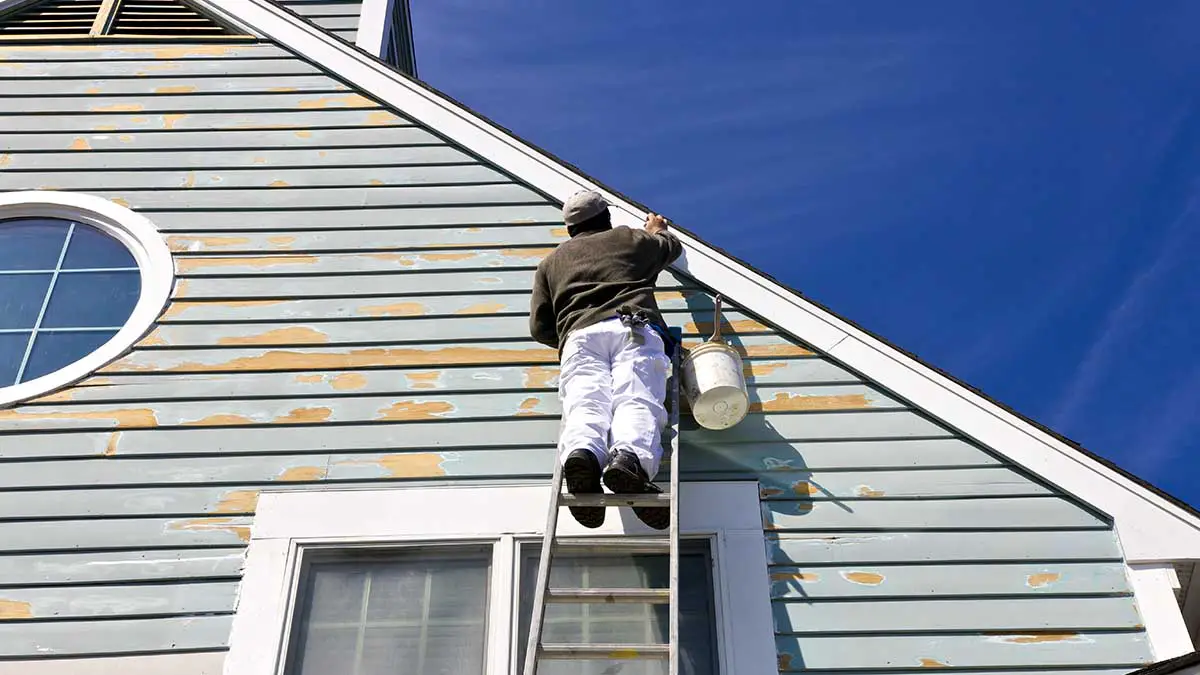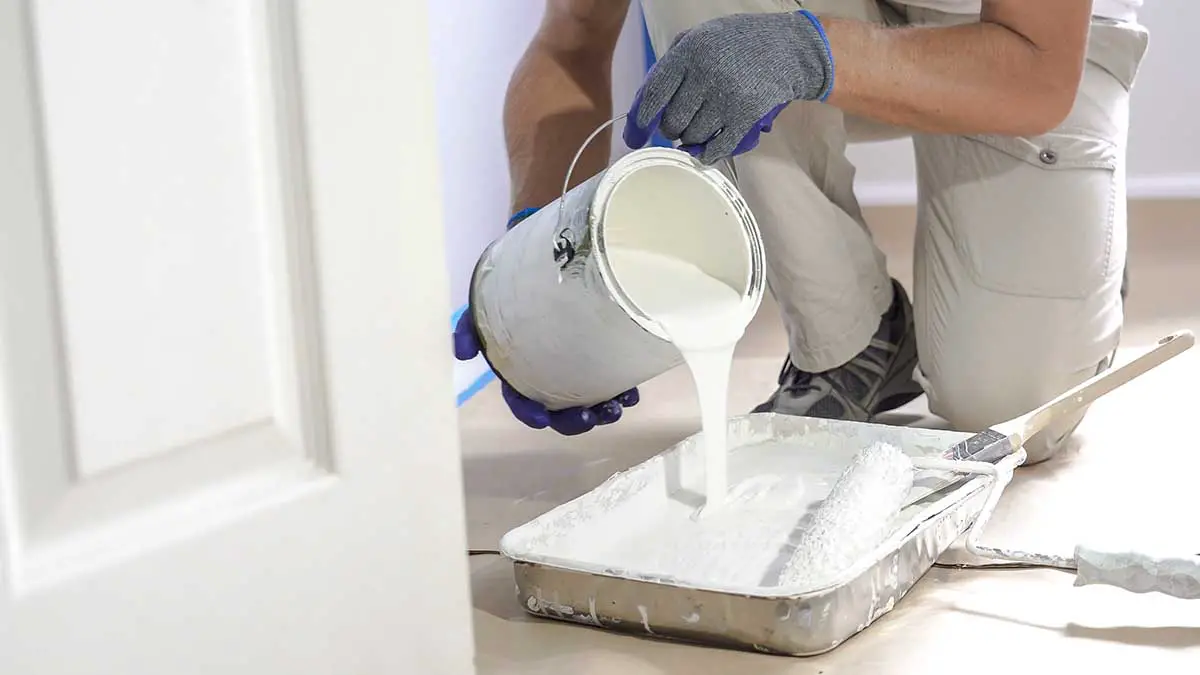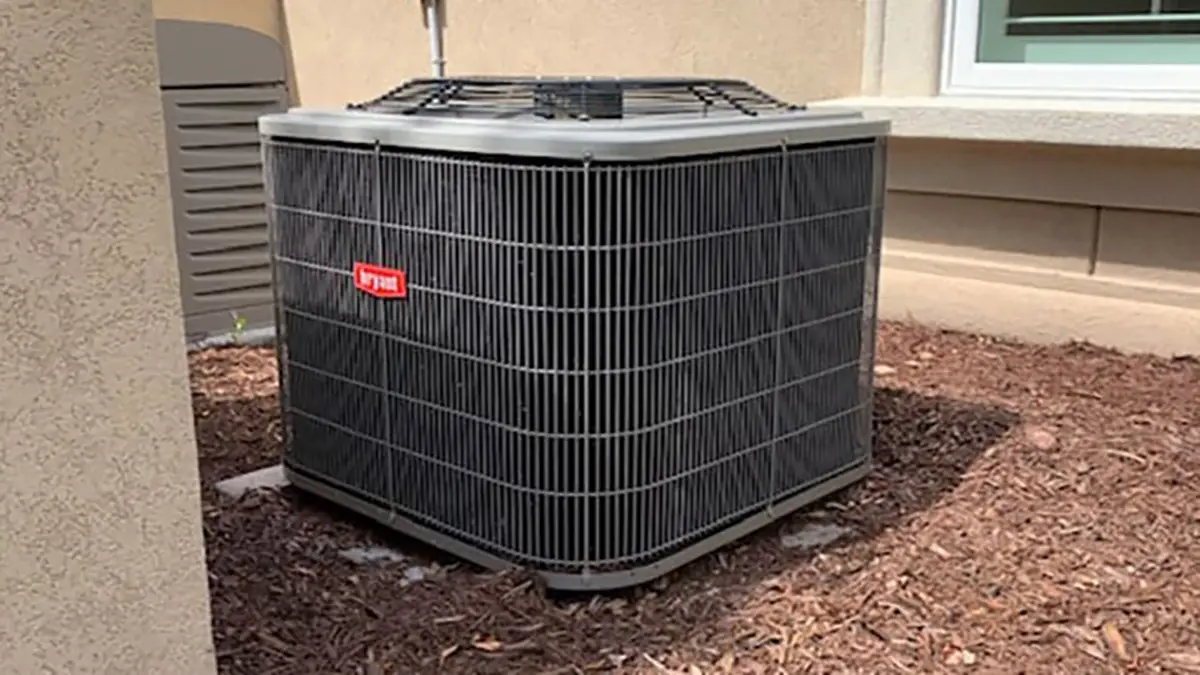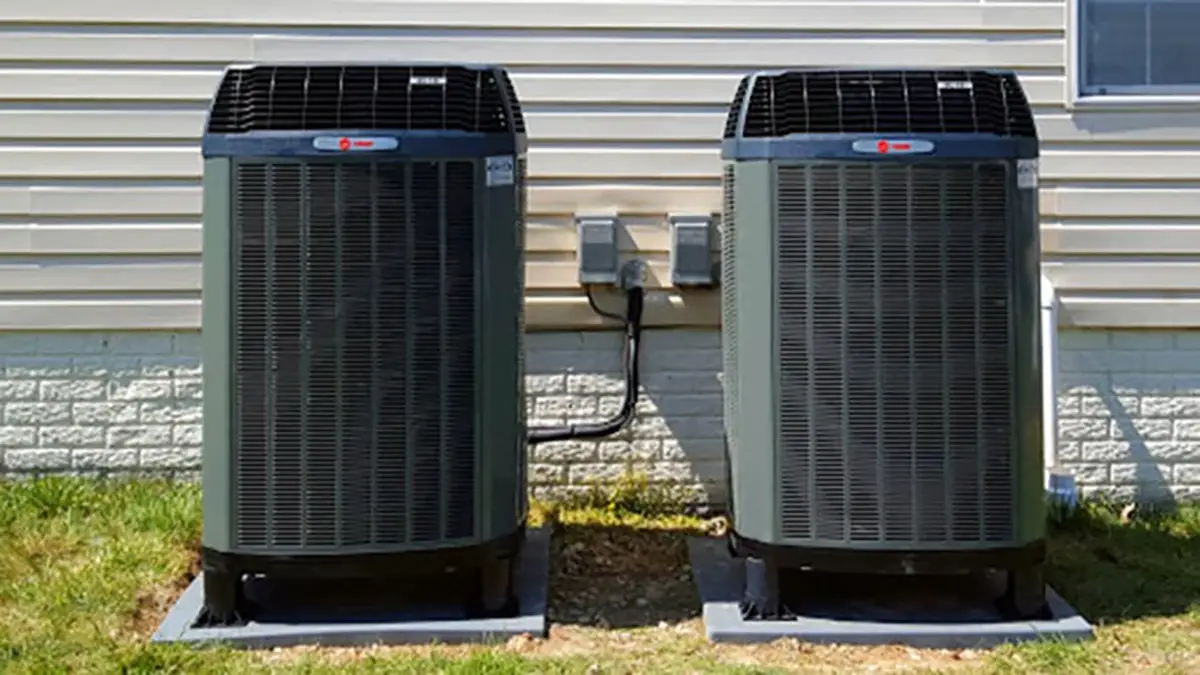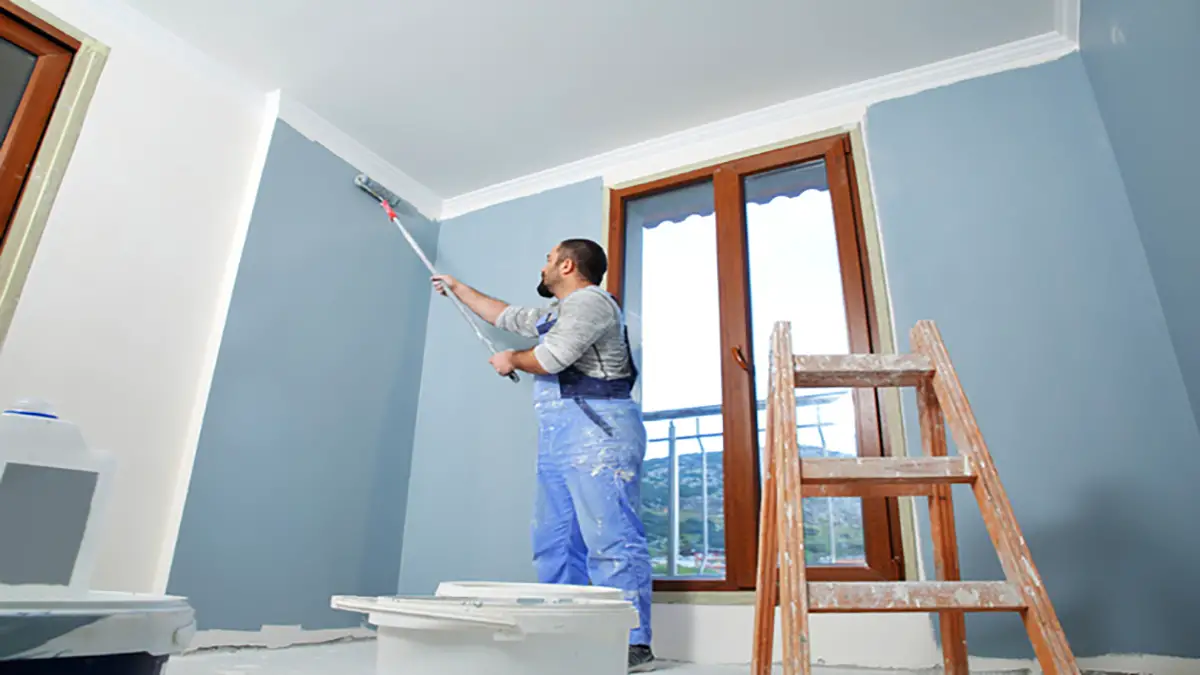Our exterior paint calculator tool is a convenient solution to estimating the cost of painting a house or the amount of paint needed for your exterior painting project. Calculate the paint you need based on your specific surface area, ensuring a seamless painting experience.
- Accuracy: Wave goodbye to guesswork. The calculator considers every nook and cranny of your home’s exterior, providing an estimate of how much paint you need that’s precise as it is reliable.
- Cost-Effective: You’ll save money by knowing the exact amount of paint needed.
- Time-Saving: Spend less time running back and forth to the store and more time bringing your vision to life. With a clear plan, your DIY paint projects transition smoothly from concept to completion.
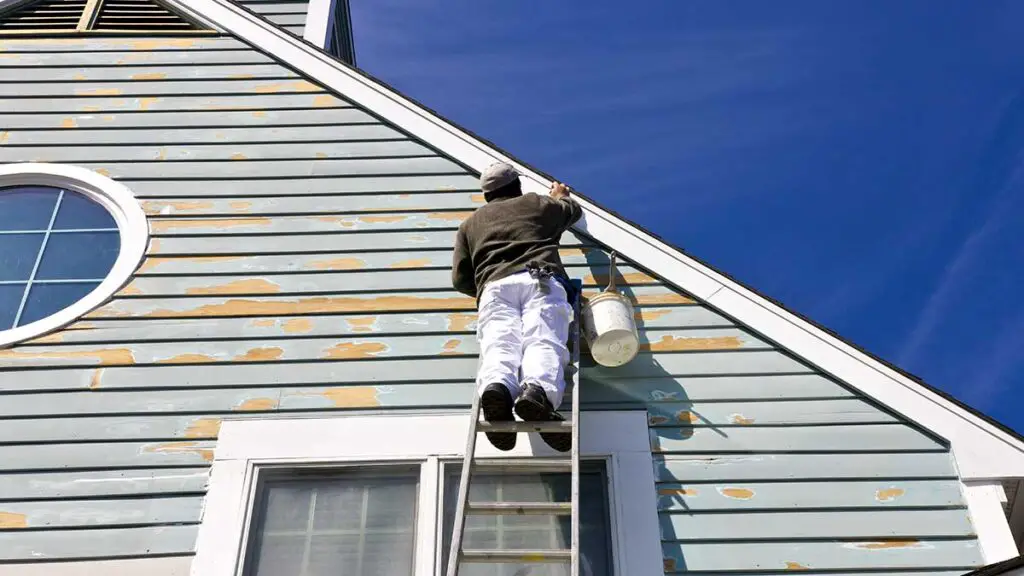
Using Our Exterior Paint Calculator
Our exterior paint calculator will estimate the cost of hiring a professional painter to paint the exterior of your house. If you prefer to do it yourself, we estimate how much exterior paint you need to purchase.
Step 1: Select Your State Location
- Why It Matters: Your location can affect several factors, including the labor and cost of materials.
- How to Do It: Choose your state from the dropdown menu. If you’re close to a border, select the state that best represents your climate and market prices.
Step 2: Enter Square Footage
- Why It Matters: The total square footage of your home directly impacts the amount of paint required.
- How to Do It: Measure the length and height of each wall and multiply to find the area. Add these together for the total exterior square footage.
Step 3: Select Prep Work
- Why It Matters: The condition of your exterior will affect how much preparation is needed before painting can begin.
- Options:
- None: Choose this if your home is new or the existing paint is in excellent condition.
- Easy: Select this for minor cleaning and a few repairs.
- Moderate: This is for homes needing some patching and more thorough cleaning.
- Extensive: Choose this for older homes or those with significant peeling or damage.
Step 4: Select the Number of Stories
- Why It Matters: More stories mean more surface area and potentially more complex scaffolding, ladders, and other equipment painters must get to hard-to-reach places.
- How to Do It: Enter the number of stories your home has.
Step 5: Select the Number of Garage Doors
- Why It Matters: Garage doors can be a significant area that requires a different paint type or color.
- How to Do It: Count and enter the number of garage doors.
Step 6: Select Siding Type
- Why It Matters: Different siding materials absorb paint differently, affecting the amount needed.
- Options: Choose from common types like wood, vinyl, brick, etc.
Step 7: Number of Exterior Doors
- Why It Matters: Like garage doors, exterior doors may need a different type of paint.
- How to Do It: Count and enter the number of exterior doors.
Step 8: Select House Design (Number of Corners)
- Why It Matters: More corners can mean more complexity and surface area.
- How to Do It: Count how many corners your house has and select the best range.
Step 9: Number of Windows
- Why It Matters: Windows are deductible from the total paintable area and require additional precision.
- How to Do It: Count and enter the total number of windows.
Step 10: Trim
- Why It Matters: Eaves (fascia and soffit) often require a different color or type of paint.
- How to Do It: Note if the eaves will be painted. We can calculate this based on the square footage.
Step 11: Number of Shutters
- Why It Matters: Shutters are usually painted in contrasting colors and must be accounted for separately.
- How to Do It: Count and enter the number of shutters.
Once you’ve navigated through these steps, your exterior paint calculator will provide a detailed overview of the paint needed for your project. This guide ensures that you consider all critical aspects, from the location and square footage to the finer details of your home’s design and condition.
Interpreting the Results:
Once you’ve input all the necessary details, the calculator will present you with the paint needed. But what does this number mean for you?
- How Much Paint You Need: It’s not just a number; it’s the key to your project’s success. This figure represents the gallons or liters you must purchase, translating your calculations into actionable steps.
- Understanding Coverage: The calculator’s output considers the average coverage per gallon of most paints. Remember, high-quality paint might cover more area with less product, affecting the Paint Consumption Calculator’s outcome.
Tips for Accuracy:
- Double-Check Everything: A slight miscalculation can lead to big surprises. Revisit each measurement and input to ensure everything is spot-on.
- Consult the Pros: If the numbers seem off or you’re unsure about certain details, don’t hesitate to consult a professional. A quick conversation could save you time and resources.
- Consider a Buffer: Always buy a little more paint than calculated. This buffer accounts for touch-ups and ensures you don’t run out mid-project.
Factors Affecting Paint Requirements
As you prepare to transform your home, it’s crucial to consider various elements that influence your paint needs. Understanding these factors ensures your Exterior Paint Calculator provides the most accurate results, making your project a resounding success.
Surface Area Calculation
Before anything else, you need a clear understanding of the surface you’re about to paint. Accurate measurements are the foundation of your project, impacting everything from the Paint Volume Calculator to the final outcome.
Consider elements like windows, doors, and trim requiring separate calculations to ensure a comprehensive approach.
The Role of Paint Type and Brand
Not all paints are created equal. The brand and type of paint you choose (latex-based, oil-based, or a specialty mixture) significantly affect coverage and longevity.
Dive into Paint Planning Tools to compare and contrast your options, ensuring you select the perfect match for your home’s exterior and climate.
Considering the Number of Coats Needed
One layer might not cut it. Multiple coats may be necessary for that flawless finish depending on your walls’ current color, condition, and the hue you’re transitioning to.

Common Mistakes to Avoid
Overestimation and Underestimation Impacts
- Overestimation: Buying too much paint can be as problematic as buying too little. It not only affects your budget but also leads to waste. Always double-check your measurements and consider the paint’s coverage rate.
- Underestimation: Running out of paint midway can derail your project’s timeline and result in color inconsistencies with different batches. Use a reliable Exterior Paint Calculator and add a small buffer to the estimated amount.
Not Accounting for Windows, Doors, and Trim
- Windows and Doors: Forgetting to subtract these from your total area will lead to overcalculating your needs. Remember, precision in the small details leads to success in the bigger picture.
- Trim Work: Trim often requires a different type or color of paint. Overlooking this detail can leave you with an incomplete or mismatched finish.
Ignoring Surface Material, Texture, and Condition
- Surface Texture: Rough surfaces like stucco or brick consume more paint. Ensure your calculator adjusts for this, or you might be short on supply.
- Pre-Existing Conditions: Previous paint conditions, mildew presence, or peeling significantly affect the prep work and amount of paint needed. Address these issues before finalizing your paint estimate.
Skipping the Prep Work Estimation
Neglecting the importance of prep work can result in underestimating the project’s size, as it entails various essential tasks like cleaning, sanding, and priming. These steps demand both time and resources.
Not Consulting with Professionals
Although DIY is praiseworthy, seeking expert advice can offer valuable perspectives that may have escaped your attention. A brief conversation could uncover aspects of your project that you had not previously considered.
Disregarding Climate and Weather Factors
The local climate can influence the choice of paint and the timing of your project. Neglecting these factors may result in weak adhesion, extended drying periods, and a less resilient final coat.
Forgetting About Future Maintenance
Consider the longevity and maintenance of your chosen paint. Some paints might be more upfront but save on touch-ups and repainting in the long run.
Advanced Features of Paint Calculators
Customizing for Multiple Colors and Surfaces
- Multiple Colors: If you’re planning a more intricate design with multiple colors, your calculator can help you determine the quantity for each. Detailing areas like trim, shutters, and doors might require different shades and types of paint.
- Varied Surfaces: Homes often have more than one type of surface. Whether wood, brick, or stucco, each might require a different approach. Advanced calculators allow you to specify these variations, ensuring accurate estimates.
Using Calculators for Trim and Accents
- Trim Details: Trim work can significantly impact your project’s aesthetic. Calculating the amount needed for these areas ensures you don’t overlook these vital elements.
- Accent Areas: You may have decorative features or accent areas requiring special attention. Advanced calculators help you account for these, ensuring every detail is considered.
Incorporating Unique Architectural Features
Homes with unique architectural features like gables, dormers, or intricate moldings require special consideration. An advanced calculator can help you estimate the additional paint needed for these complex areas.
Adjusting for Paint Quality and Type
Higher-quality paints often offer better coverage and durability. If investing in premium options, your calculator can adjust the quantity needed based on the manufacturer’s coverage specifications.
Factoring in Historical and Environmental Data
Some advanced calculators consider historical weather data and environmental factors affecting paint longevity and application. This feature can be particularly useful in areas with extreme climate conditions.
Project Cost Estimation
Beyond just the paint, advanced calculators can provide a broader cost estimation, incorporating additional materials like primer, caulking, and even labor if you’re considering professional help.
Saving and Sharing Your Estimates
Look for a feature that allows you to save your calculations for future reference or share them with contractors or consultants for further advice.
FAQs
How do I figure out how much paint I need for my exterior?
To determine how much paint you need for your exterior, measure the height and width of each surface you plan to paint. Multiply the height by the width to get the square footage of each surface. Add up the square footage of all surfaces. Divide the total square footage by the paint’s coverage rate to determine how many gallons you need.
How much paint is needed to paint a 2000 square foot house exterior?
It depends on the type of paint used, the number of coats required, and how much surface area you need to paint. A rough estimate, you will need approximately 10-20 gallons of paint to cover the exterior of a 2000 square foot house.
How do I calculate the exterior surface area of my home?
To calculate the exterior surface area, measure the height and width of each wall and multiply them together. Then, add the areas of all walls to get the total exterior surface area. Remember to subtract the areas of windows, doors, and any other spaces that won’t be painted.
Can I use an exterior paint calculator for textured surfaces?
Yes, our exterior paint calculator accounts for textured surfaces. Textured surfaces generally require more paint due to their increased surface area, so indicate this in the calculator to get a more accurate estimate.
What if my project requires multiple paint colors?
If you’re using multiple colors, divide your project into sections, each with its own color. Calculate the paint needed for each section separately and then sum the totals. Ensure you plan where each color goes to avoid confusion and waste.
How should I account for a primer in my paint calculations?
Primer is crucial for ensuring a smooth, even coat of paint, especially when working with raw surfaces or making drastic color changes. Most paint calculators will include an option to factor in primer. If not, calculate the primer needed based on the manufacturer’s coverage rate, just like you would with the paint.
Does the type of siding on my house affect how much paint I’ll need?
Absolutely. Different siding materials absorb paint differently. For instance, porous materials like stucco require more paint than non-porous materials like vinyl. Specify your siding type in the paint calculator to adjust the estimate accordingly.
How many coats of paint do I need?
The number of coats depends on several factors, including the color you’re covering, the color you’re applying, and the type of paint you’re using. A general rule is that darker colors over lighter ones or significant color changes might require more coats. High-quality paints might also offer better coverage with fewer coats.
Try our Interior Paint Calculator and our House Painting Cost Estimator.
- Aznar AC, Pardini OR, Amalvy JI. Glossy topcoat exterior paint formulations using water-based polyurethane/acrylic hybrid binders. Progress in organic coatings. 2006 Jan 1;55(1):43-9.


